Related Research Articles
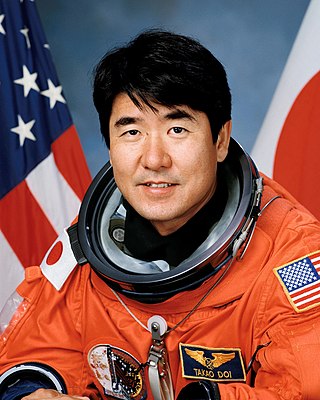
Takao Doi is a Japanese astronaut, engineer and veteran of two NASA Space Shuttle missions.

Hayabusa was a robotic spacecraft developed by the Japan Aerospace Exploration Agency (JAXA) to return a sample of material from a small near-Earth asteroid named 25143 Itokawa to Earth for further analysis. Hayabusa, formerly known as MUSES-C for Mu Space Engineering Spacecraft C, was launched on 9 May 2003 and rendezvoused with Itokawa in mid-September 2005. After arriving at Itokawa, Hayabusa studied the asteroid's shape, spin, topography, color, composition, density, and history. In November 2005, it landed on the asteroid and collected samples in the form of tiny grains of asteroidal material, which were returned to Earth aboard the spacecraft on 13 June 2010.

Chiaki Mukai is a Japanese physician and JAXA astronaut. She was the first Japanese woman in space, the first Japanese citizen to have two spaceflights, and the first Asian woman in space. Both were Space Shuttle missions; her first was STS-65 aboard Space Shuttle Columbia in July 1994, which was a Spacelab mission. Her second spaceflight was STS-95 aboard Space Shuttle Discovery in 1998. In total she has spent 23 days in space.
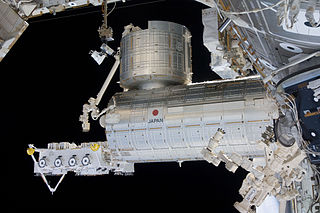
The National Space Development Agency of Japan, or NASDA, was a Japanese national space agency established on October 1, 1969 under the National Space Development Agency Law only for peaceful purposes. Based on the Space Development Program enacted by the Minister of Education, Culture, Sports, Science and Technology (MEXT), NASDA was responsible for developing satellites and launch vehicles as well as launching and tracking them.

The Japan Aerospace Exploration Agency (JAXA) is the Japanese national air and space agency. Through the merger of three previously independent organizations, JAXA was formed on 1 October 2003. JAXA is responsible for research, technology development and launch of satellites into orbit, and is involved in many more advanced missions such as asteroid exploration and possible human exploration of the Moon. Its motto is One JAXA and its corporate slogan is Explore to Realize.
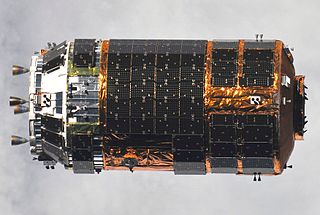
The H-II Transfer Vehicle (HTV), also called Kounotori, is an expendable, automated cargo spacecraft used to resupply the Kibō Japanese Experiment Module (JEM) and the International Space Station (ISS). The Japan Aerospace Exploration Agency (JAXA) has been working on the design since the early 1990s. The first mission, HTV-1, was originally intended to be launched in 2001. It launched at 17:01 UTC on 10 September 2009 on an H-IIB launch vehicle. The name Kounotori was chosen for the HTV by JAXA because "a white stork carries an image of conveying an important thing, therefore, it precisely expresses the HTV's mission to transport essential materials to the ISS". The HTV is very important for resupplying the ISS because after the retirement of the Space Shuttle it is the only vehicle that can transfer new 41.3 in (105 cm) wide International Standard Payload Racks (ISPRs) and dispose old ISPRs that can fit the 51 in (130 cm) wide tunnels between modules in the US Orbital Segment.
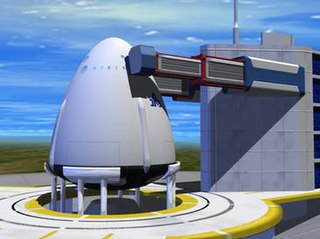
The Kankoh-maru is a proposed vertical takeoff and landing (VTVL), single-stage-to-orbit (SSTO), reusable launch system. According to a document from July 1997, it would have been manufactured by Kawasaki Heavy Industries and Mitsubishi Heavy Industries, with its formal name being the Kawasaki S-1.

Fuji (ふじ) was a crewed spacecraft of the space capsule kind, proposed by Japan's National Space Development Agency (NASDA) Advanced mission Research center in December 2001. The Fuji design was ultimately not adopted.
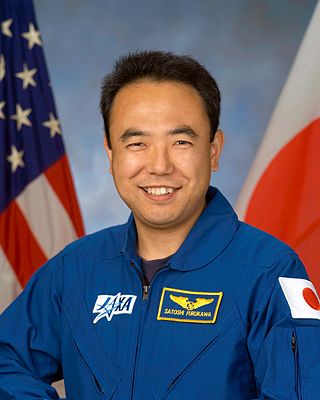
Satoshi Furukawa is a Japanese surgeon and JAXA astronaut. Furukawa was assigned to the International Space Station as a flight engineer on long-duration missions Expedition 28/29, lifting off 7 June 2011 and returning 22 November 2011.
The Institute for Unmanned Space Experiment Free Flyer (USEF) (財団法人無人宇宙実験システム研究開発機構) was a Japanese space agency, which was founded by the Ministry of International Trade and Industry in 1986. Unlike NASDA, ISAS, and NAL, it was not included in the JAXA organization, which was founded in 2003. The chairperson is Ichiro Taniguchi.

Kakuda Space Center is a facility of the Japan Aerospace Exploration Agency (JAXA), located in the city of Kakuda in Miyagi Prefecture in northern Japan, specializing in the development and testing of rocket engines and space propulsion systems. The LE-5, and the LE-7 rocket enginese were developed at the Kakuda Space Center.

Chōfu Aerospace Center is the headquarters and main development facility for the Japan Aerospace Exploration Agency (JAXA).

The Japanese space program originated in the mid-1950s as a research group led by Hideo Itokawa at the University of Tokyo. The size of the rockets produced gradually increased from under 30 cm (12 in) at the start of the project, to over 15 m (49 ft) by the mid-1960s. The aim of the original research project was to launch a man-made satellite.
The (Japanese) Lunar Exploration Program (月探査計画) is a program of robotic and human missions to the Moon undertaken by the Japanese Aerospace Exploration Agency (JAXA) and its division, the Institute of Space and Astronautical Science (ISAS). It is also one of the three major enterprises of the JAXA Space Exploration Center (JSPEC). The main goal of the program is "to elucidate the origin and evolution of the Moon and utilize the Moon in the future".

The Epsilon Launch Vehicle, or Epsilon rocket, is a Japanese solid-fuel rocket designed to launch scientific satellites. It is a follow-on project to the larger and more expensive M-V rocket which was retired in 2006. The Japan Aerospace Exploration Agency (JAXA) began developing the Epsilon in 2007. It is capable of placing a 590 kg payload into Sun-synchronous orbit.
New Space-Station Resupply Vehicle, tentatively called HTV-X, is an uncrewed expendable cargo spacecraft under development by Japan Aerospace Exploration Agency (JAXA) as the successor of H-II Transfer Vehicle (HTV). As of October 2022 the first flight is planned to be launched in January 2024 to resupply International Space Station.
The X-Ray Imaging and Spectroscopy Mission, formerly the X-ray Astronomy Recovery Mission (XARM), is an X-ray astronomy satellite of the Japan Aerospace Exploration Agency (JAXA) to provide breakthroughs in the study of structure formation of the universe, outflows from galaxy nuclei, and dark matter. As the only international X-ray observatory project of its period, XRISM will function as a next generation space telescope in the X-ray astronomy field, similar to how the James Webb Space Telescope, Fermi Space Telescope, and the Atacama Large Millimeter Array (ALMA) Observatory are placed in their respective fields. The mission is a stopgap for avoiding a potential observation period gap between X-ray telescopes of the present and those of the future. Without XRISM, a blank period in X-ray astronomy may arise in the early 2020s due to the loss of Hitomi. During its formulation, XRISM/XARM was also known as the "ASTRO-H Successor" or "ASTRO-H2".
WIRES is a Japanese project developing a winged single-stage reusable suborbital rocket as a test bed for a reusable orbital launch system or a crewed suborbital spaceplane. The full-size prototype, called WIRES-X, is expected to be launched in 2020.
Makoto Suwa is a Japanese astronaut candidate selected by the Japan Aerospace Exploration Agency (JAXA).
References
- ↑ "JAXA | NAL History". global.jaxa.jp. Retrieved 2022-02-20.
- 1 2 Tomifumi Godai (1994-04-30). 国産ロケット「H-II」宇宙への挑戦[Domestic rocket H-II space challenge] (in Japanese). Tokuma Shoten. ISBN 4-19-860100-3.
- 1 2 Kamiya, Setsuko, "Japan a low-key player in space race Archived 3 August 2009 at the Wayback Machine ", Japan Times , 30 June 2009, p. 3.
- ↑ Astronautix article on ALFLEX
- ↑ ALFLEX page on JAXA (global)
- ↑ "HOPE_X 開発から将来宇宙輸送系に向けて" [HOPE_X Lessons Learned for Future Space Transportation Systems](PDF). Technical Review (in Japanese). MHI. January 2002. Retrieved 2023-07-03.
- ↑ "High Speed Flight Demonstration "HSFD"". Technical Review. JAXA. July 2003. Retrieved 2023-07-03.
- ↑ Jos Heyman, "Spaceplanes That Never Were...," MilSat Magazine, Sept. 2016. Retrieved 2023-07-03.
- ↑ 札幌試験場視察 [Visit to Sapporo Proving Ground](PDF). Electronic Equipment Research Institute / Advanced Technology Promotion Center Headquarters Kobo [newsletter] (in Japanese). No. 503. General Affairs Division, General Affairs Department, Technology Research Headquarters, Ministry of Defense. 8 March 2010. p. 2. Archived from the original (PDF) on 5 March 2016.
- ↑ "Niijima". Encyclopedia Astronautica. Archived from the original on 21 November 2019.
- ↑ Nagata, Harunori (7 February 2004). "The Forefront of Space Science: Hybrid Rocket "CAMUI"". Institute of Space and Astronautical Science (ISAS). p. 2. Archived from the original on 1 October 2006.
- ↑ "National Aerospace Laboratory of Japan's Numerical Wind Tunnel-Computer Museum". museum.ipsj.or.jp. Retrieved 2022-02-20.
- ↑ "Sublist Generator". top500.org. Retrieved 3 July 2023.
- ↑ TOP500 Annual Report 1994.
- ↑ N. Hirose and M. Fukuda (1997). Numerical Wind Tunnel (NWT) and CFD Research at National Aerospace Laboratory. Proceedings of HPC-Asia '97. IEEE Computer Society. doi:10.1109/HPC.1997.592130.
- ↑ "Law Concerning Japan Aerospace Exploration Agency" (PDF). JAXA. Retrieved 3 July 2023.
- ↑ "Integration of three space agencies". Research and Development Bureau Ministry of Education. 2003-06-14. Archived from the original on January 27, 2013. Retrieved 2023-07-03.